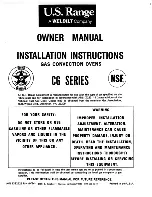
REMOVING THE DOOR / THE DOOR GLASS
Warning: use protective gloves for the following operations.
Follow these instructions very carefully to prevent injury and
damaging the oven door and hinges. Make a careful note of
the position of the pieces of glass before dismantling it so that
you fit them back on again in the right position. Do not touch
the hinges when cleaning and/or removing the door (Fig. 1).
How to remove the oven door:
• Use protective gloves.
• Open the door fully (see Fig. 2).
• Lift the two catches and push them forward as far as they can go
(see Fig. 3).
• Partially close the door to remove it, lifting it upwards (see Fig. 4).
To remove the glass from the oven door:
• Place the oven door on a flat surface (Fig. 5).
• Slacken the screws on the two glass supports (A) next to the
hinges and put them to the side (Fig. 5, Fig. 6).
When should a pyrolytic cycle be used?
This function should be used if the oven is smoking when heating up
and there is a lot of smoke when cooking, or when there are
unpleasant smells when the oven is cold after cooking different kinds
of food (lamb, fish, grilled meats, etc.).
COOKING THAT LEAVES LITTLE TRACE OF DIRT
Biscuits, vegetables, cakes, quiches, soufflés. They do not splatter
when cooking.
COOKING THAT PRODUCES AN AVERAGE AMOUNT OF
DIRT
Meat, fish (in an oven tray), stuffed vegetables.
COOKING THAT PRODUCES A LARGE AMOUNT OF DIRT
Large pieces of meat on a spit or use of the Turbogrill.
Care and Maintenance
(continuation)
11
Fig. 3
Fig. 1
Fig
. 2
Fig. 4
Fig.
5
Fig. 6


































